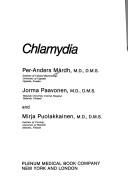| Listing 1 - 10 of 24 | << page >> |
Sort by
|
Book
Year: 1983 Publisher: London : Churchill Livingstone,
Abstract | Keywords | Export | Availability | Bookmark
 Loading...
Loading...Choose an application
- Reference Manager
- EndNote
- RefWorks (Direct export to RefWorks)
Book
ISBN: 1912530295 9781912530298 1912530287 9781912530281 Year: 2020 Publisher: Norfolk Caister Academic Press
Abstract | Keywords | Export | Availability | Bookmark
 Loading...
Loading...Choose an application
- Reference Manager
- EndNote
- RefWorks (Direct export to RefWorks)
Chlamydia infections. --- Chlamydia infections --- Diagnosis.
Book
ISBN: 1000796205 1003337511 1003337511 1000793435 8793609507 Year: 2018 Publisher: Denmark : River Publishers,
Abstract | Keywords | Export | Availability | Bookmark
 Loading...
Loading...Choose an application
- Reference Manager
- EndNote
- RefWorks (Direct export to RefWorks)
Book
ISBN: 9782743005429 2743005424 Year: 2002 Publisher: Paris: Tec & Doc,
Abstract | Keywords | Export | Availability | Bookmark
 Loading...
Loading...Choose an application
- Reference Manager
- EndNote
- RefWorks (Direct export to RefWorks)

ISBN: 0306429659 Year: 1989 Publisher: New York (N.Y.) : Plenum medical book,
Abstract | Keywords | Export | Availability | Bookmark
 Loading...
Loading...Choose an application
- Reference Manager
- EndNote
- RefWorks (Direct export to RefWorks)
Book
ISBN: 9789021901657 902190165X Year: 1971 Publisher: [Amsterdam],
Abstract | Keywords | Export | Availability | Bookmark
 Loading...
Loading...Choose an application
- Reference Manager
- EndNote
- RefWorks (Direct export to RefWorks)
Chlamydia Infections. --- Chlamydia. --- Trachoma.
Book
Year: 2011 Publisher: [Atlanta, Ga.] : Department of Health & Human Services, Centers for Disease Control and Prevention,
Abstract | Keywords | Export | Availability | Bookmark
 Loading...
Loading...Choose an application
- Reference Manager
- EndNote
- RefWorks (Direct export to RefWorks)
Book
ISBN: 1837687617 Year: 2023 Publisher: London : IntechOpen,
Abstract | Keywords | Export | Availability | Bookmark
 Loading...
Loading...Choose an application
- Reference Manager
- EndNote
- RefWorks (Direct export to RefWorks)
Chlamydia infections continue to pose a serious socioeconomic burden globally. Despite advances in diagnostic tests in recent decades, chlamydial infections still cannot be controlled, neither in developed countries nor in developing countries. Chlamydial infections date back to the beginning of recorded human history. Trachoma caused by Chlamydia trachomatis, which progresses to blindness, is mentioned in ancient Chinese inscriptions and Egyptian scrolls. Today, we must better apply our knowledge against this clever and evolving obligate intracellular parasitic microorganism. Chlamydia - Secret Enemy from Past to Present examines chlamydial infections using a comprehensive multidisciplinary approach. It discusses the microbiology, clinical presentation, and current approaches in the diagnosis and treatment management of chlamydial infection from the viewpoint of different clinics as well as includes relevant and recent literature.
Infectious & contagious diseases. --- Chlamydia --- Chlamydia infections. --- Chlamydia infections --- Infections. --- History.
Book
ISBN: 9780875531557 0875531555 Year: 1989 Publisher: Washington (D.C.): American Public Health Association,
Abstract | Keywords | Export | Availability | Bookmark
 Loading...
Loading...Choose an application
- Reference Manager
- EndNote
- RefWorks (Direct export to RefWorks)
Rickettsial diseases --- Chlamydia infections --- Diagnostic virology
Book

Year: 2014 Publisher: Frontiers Media SA
Abstract | Keywords | Export | Availability | Bookmark
 Loading...
Loading...Choose an application
- Reference Manager
- EndNote
- RefWorks (Direct export to RefWorks)
The chlamydiae are Gram-negative, obligate intracellular bacteria with a complex developmental cycle comprising a metabolically less-active, infectious stage, the elementary body (EB), and a metabolically more active stage, the reticulate body (RB). They are responsible for many acute and chronic diseases in humans and animals. In order to play a causative role in chronic diseases, chlamydiae would need to persist and to re-activate within infected cells/tissues for extended periods of time. Persistence in vitro is defined as viable but non-cultivable chlamydiae involving morphologically enlarged, aberrant, and nondividing RBs, termed aberrant bodies (AB). In vitro, alterations of the normal developmental cycle of chlamydiae can be induced by the addition of Interferon-? (IFN-?), tumor necrosis factor-a (TNF-a) and penicillin G exposure as well as amino acid or iron deprivation, monocyte infection and co-infection with viruses. In vivo, key questions include whether or not ABs occur in infected patients and animals and whether such ABs can contribute to prolonged, chronic inflammation, fibrosis, and scarring through continuing stimulation of the host immune system known from diseases such as trachoma, pelvic inflammatory disease, reactive arthritis and atherosclerosis. To date, the direct causal role in the pathogenesis of chlamydial infection and persistence in vivo has been questioned since there was no tractable animal model of chlamydial persistence so far. A very recent study was able to establish an experimental animal model of in vivo persistence, when C. muridarum vaginally-infected mice were gavaged with amoxicillin. Amoxicillin treatment induced C. muridarum to enter the persistent state in vivo. Recent in vivo data from patients indicate that viable but non-infectious developmental stages are present in the genital tract of chronically-infected women and that the gastrointestinal tract might be a reservoir for persistent chlamydial infections at other sites.
Chlamydia infections. --- stress response --- chlamydia --- Chronic Disease
| Listing 1 - 10 of 24 | << page >> |
Sort by
|

 Search
Search Feedback
Feedback About UniCat
About UniCat  Help
Help News
News